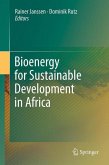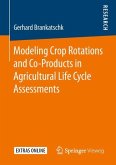Coviability of Social and Ecological Systems: Reconnecting Mankind to the Biosphere in an Era of Global Change
Vol.1 : The Foundations of a New Paradigm
Herausgegeben:Barrière, Olivier; Behnassi, Mohamed; David, Gilbert; Douzal, Vincent; Fargette, Mireille; Libourel, Thérèse; Loireau, Maud; Pascal, Laurence; Prost, Catherine
Coviability of Social and Ecological Systems: Reconnecting Mankind to the Biosphere in an Era of Global Change
Vol.1 : The Foundations of a New Paradigm
Herausgegeben:Barrière, Olivier; Behnassi, Mohamed; David, Gilbert; Douzal, Vincent; Fargette, Mireille; Libourel, Thérèse; Loireau, Maud; Pascal, Laurence; Prost, Catherine
- Gebundenes Buch
- Merkliste
- Auf die Merkliste
- Bewerten Bewerten
- Teilen
- Produkt teilen
- Produkterinnerung
- Produkterinnerung
This book considers the principle of 'sustainable development' which is currently facing a growing environmental crisis. A new mode of thinking and positioning the ecological imperative is the major input of this volume. The prism of co-viability is not the economics of political agencies that carry the ideology of the dominant/conventional economic schools, but rather an opening of innovation perspectives through science. This volume, through its four parts, more than 40 chapters and a hundred authors, gives birth to a paradigm which crystallizes within a concept that will support in overcoming the ecological emergency deadlock.…mehr
Andere Kunden interessierten sich auch für
![Coviability of Social and Ecological Systems: Reconnecting Mankind to the Biosphere in an Era of Global Change Coviability of Social and Ecological Systems: Reconnecting Mankind to the Biosphere in an Era of Global Change]() Coviability of Social and Ecological Systems: Reconnecting Mankind to the Biosphere in an Era of Global Change98,99 €
Coviability of Social and Ecological Systems: Reconnecting Mankind to the Biosphere in an Era of Global Change98,99 €![Human and Environmental Security in the Era of Global Risks Human and Environmental Security in the Era of Global Risks]() Human and Environmental Security in the Era of Global Risks98,99 €
Human and Environmental Security in the Era of Global Risks98,99 €![Advanced Studies in Energy Efficiency and Built Environment for Developing Countries Advanced Studies in Energy Efficiency and Built Environment for Developing Countries]() Advanced Studies in Energy Efficiency and Built Environment for Developing Countries76,99 €
Advanced Studies in Energy Efficiency and Built Environment for Developing Countries76,99 €![Facing Up to Global Warming Facing Up to Global Warming]() N.F. GrayFacing Up to Global Warming38,99 €
N.F. GrayFacing Up to Global Warming38,99 €![Bioenergy for Sustainable Development in Africa Bioenergy for Sustainable Development in Africa]() Bioenergy for Sustainable Development in Africa115,99 €
Bioenergy for Sustainable Development in Africa115,99 €![Modeling Crop Rotations and Co-Products in Agricultural Life Cycle Assessments Modeling Crop Rotations and Co-Products in Agricultural Life Cycle Assessments]() Gerhard BrankatschkModeling Crop Rotations and Co-Products in Agricultural Life Cycle Assessments49,99 €
Gerhard BrankatschkModeling Crop Rotations and Co-Products in Agricultural Life Cycle Assessments49,99 €![Sustainable Solutions for Food Security Sustainable Solutions for Food Security]() Sustainable Solutions for Food Security85,99 €
Sustainable Solutions for Food Security85,99 €-
-
-
This book considers the principle of 'sustainable development' which is currently facing a growing environmental crisis. A new mode of thinking and positioning the ecological imperative is the major input of this volume. The prism of co-viability is not the economics of political agencies that carry the ideology of the dominant/conventional economic schools, but rather an opening of innovation perspectives through science. This volume, through its four parts, more than 40 chapters and a hundred authors, gives birth to a paradigm which crystallizes within a concept that will support in overcoming the ecological emergency deadlock.
Produktdetails
- Produktdetails
- Verlag: Springer / Springer International Publishing / Springer, Berlin
- Artikelnr. des Verlages: 978-3-319-78496-0
- 1st edition 2019
- Seitenzahl: 812
- Erscheinungstermin: 20. März 2019
- Englisch
- Abmessung: 241mm x 160mm x 49mm
- Gewicht: 1374g
- ISBN-13: 9783319784960
- ISBN-10: 331978496X
- Artikelnr.: 51205640
- Herstellerkennzeichnung
- Springer-Verlag GmbH
- Tiergartenstr. 17
- 69121 Heidelberg
- ProductSafety@springernature.com
- Verlag: Springer / Springer International Publishing / Springer, Berlin
- Artikelnr. des Verlages: 978-3-319-78496-0
- 1st edition 2019
- Seitenzahl: 812
- Erscheinungstermin: 20. März 2019
- Englisch
- Abmessung: 241mm x 160mm x 49mm
- Gewicht: 1374g
- ISBN-13: 9783319784960
- ISBN-10: 331978496X
- Artikelnr.: 51205640
- Herstellerkennzeichnung
- Springer-Verlag GmbH
- Tiergartenstr. 17
- 69121 Heidelberg
- ProductSafety@springernature.com
Chapter 1: Introductory Chapter: Formalizing a Paradigm, the Biosphere face to the Relationship Between Human and Non-Human(Barrière).- Chapter 2: Coviability and Biodiversity Conservation at The Crossroads of Socio-Ecological Interactions(Lévêque).- Chapter 3: Coviability, Through the Lens of the Mathematical Theory of Viability(Aubin).- Chapter 4: A Mathematical Approach to Coviability: Concept, Modeling and Control(El Jai).- Chapter 5: The Relationships Between man and his Environment: A Systemic Approach to the Viability of System Earth(Fargette).- Chapter 6: Socio-Ecological Viability and Legal Regulation: Pluralism and Endogeneity - for an Anthropological Dimension of Environmental law(Barrière).- Chapter 7: The Paradigm of Coviability Defined by the Adequacy Between Social Usefulness and the Ecological Function: The Legal Challenge of the Socio-Ecological Connection(Barrière).- Chapter 8: The Local Ecological Knowledge and the Viability ofthe Relations With the Environment(Sabinot).- Chapter 9: A Biological Approach to Coviability: Biotics Interactions and Dynamics of Biodiversity(Pascal).- Chapter 10: A Geographical Approach of the Socio-Ecosystem Coviability(Grenier).- Chapter 11: A Rupture Between Human Beings and Earth: A Philosophical Critical Approach to Coviability(Bertrand).- Chapter 12: When Coviability Meets Ecosystem Services: The Case of Reunion Island's Coral Reefs(Cillaurren).- Chapter 13: Governance of Protected Areas as a Tool for Coviability(David).- Chapter 14: Social-Ecological Coviability of the Protected Marine Areas in Brazil(Prost).- Chapter 15: Socio-Ecological Coviability Confronted With the Neoliberal System, The Peace Parks (Southern Africa)(Belaïdi).- Chapter 16: Coviability in the Governance of Pastoral Systems, Permanence and Change(Sraïri).- Chapter 17: Developing Coviability Through an eco-Pastoral Approach, the European Project LIFE + MIL'OUV(Lepart).- Chapter 18: Reconnecting man to man: Socio-Cultural Coviability Ties and Interculturality -Practical Research in a Sensitive Neighborhood in Montpellier, France(Barrière).- Chapter 19: Kinship as an Instrument for Coviability: Study Cases in Pará, Amazonia.- Chapter 20: The Price of Coviability: Pollination at all Costs; Legal Approach of the new Relationship Between man and Pollinators(Billet).- Chapter 21: Can the International and French Environment law Accommodate Coviability?(Treillard).- Chapter 22: Climate Change, a Catalyst for Coviability and for a new Utopia(Coudrain).- Chapter 23: Approaching the Human-Environment Nexus Beyond Conflict: A Peace and Coviability Perspective(Behnassi).- Chapter 24: The Link to the Biosphere: Humanity Condemned to Otherness and Coviability for its Existence(Essono).- Chapter 25: Tracking The Origin of Western's Man-Biosphere Disconnection, Opening a View to a Change(Douzal).- Chapter26: Transversal Ontology Analysis: What Coviability Means(Libourel).- Chapter 27: Coviability as a Scientific Paradigm for the Ecological Transition, From an Overview to a Definition(Barrière).
Chapter 1: Introductory Chapter: Formalizing a Paradigm, the Biosphere face to the Relationship Between Human and Non-Human(Barrière).- Chapter 2: Coviability and Biodiversity Conservation at The Crossroads of Socio-Ecological Interactions(Lévêque).- Chapter 3: Coviability, Through the Lens of the Mathematical Theory of Viability(Aubin).- Chapter 4: A Mathematical Approach to Coviability: Concept, Modeling and Control(El Jai).- Chapter 5: The Relationships Between man and his Environment: A Systemic Approach to the Viability of System Earth(Fargette).- Chapter 6: Socio-Ecological Viability and Legal Regulation: Pluralism and Endogeneity - for an Anthropological Dimension of Environmental law(Barrière).- Chapter 7: The Paradigm of Coviability Defined by the Adequacy Between Social Usefulness and the Ecological Function: The Legal Challenge of the Socio-Ecological Connection(Barrière).- Chapter 8: The Local Ecological Knowledge and the Viability ofthe Relations With the Environment(Sabinot).- Chapter 9: A Biological Approach to Coviability: Biotics Interactions and Dynamics of Biodiversity(Pascal).- Chapter 10: A Geographical Approach of the Socio-Ecosystem Coviability(Grenier).- Chapter 11: A Rupture Between Human Beings and Earth: A Philosophical Critical Approach to Coviability(Bertrand).- Chapter 12: When Coviability Meets Ecosystem Services: The Case of Reunion Island's Coral Reefs(Cillaurren).- Chapter 13: Governance of Protected Areas as a Tool for Coviability(David).- Chapter 14: Social-Ecological Coviability of the Protected Marine Areas in Brazil(Prost).- Chapter 15: Socio-Ecological Coviability Confronted With the Neoliberal System, The Peace Parks (Southern Africa)(Belaïdi).- Chapter 16: Coviability in the Governance of Pastoral Systems, Permanence and Change(Sraïri).- Chapter 17: Developing Coviability Through an eco-Pastoral Approach, the European Project LIFE + MIL'OUV(Lepart).- Chapter 18: Reconnecting man to man: Socio-Cultural Coviability Ties and Interculturality -Practical Research in a Sensitive Neighborhood in Montpellier, France(Barrière).- Chapter 19: Kinship as an Instrument for Coviability: Study Cases in Pará, Amazonia.- Chapter 20: The Price of Coviability: Pollination at all Costs; Legal Approach of the new Relationship Between man and Pollinators(Billet).- Chapter 21: Can the International and French Environment law Accommodate Coviability?(Treillard).- Chapter 22: Climate Change, a Catalyst for Coviability and for a new Utopia(Coudrain).- Chapter 23: Approaching the Human-Environment Nexus Beyond Conflict: A Peace and Coviability Perspective(Behnassi).- Chapter 24: The Link to the Biosphere: Humanity Condemned to Otherness and Coviability for its Existence(Essono).- Chapter 25: Tracking The Origin of Western's Man-Biosphere Disconnection, Opening a View to a Change(Douzal).- Chapter26: Transversal Ontology Analysis: What Coviability Means(Libourel).- Chapter 27: Coviability as a Scientific Paradigm for the Ecological Transition, From an Overview to a Definition(Barrière).









